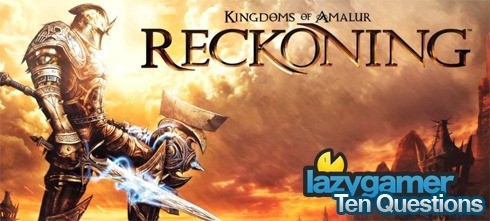
I’m sure many of you reading know that I’ve been telling pretty much anyone willing to listen that I’m pretty excited for Kingdoms of Amalur: The Reckoning, the action-RPG from 38 Studios and Big Huge Games that takes a little bit of a Dragon Age, a dash of God of War, a teaspoon of World of Warcraft, a bucket of Skyrim and a lot of Fable and mixes it up in to a beautiful, combat-driven RPG experience. I’ve been playing the demo quite extensively, and while it has got a few issues – mostly a dodgy camera and a few graphical bugs and glitches – it’s still very much at the top of my “must-have” list.
I think, despite its aesthetic similarities to other games in the genre (principally, World of Warcraft and Fable) it’ll be an amazing, unique experience , and could well end up being one of the year’s sleeper hits. We got to ask Colin Campbell, the game’s lead world designer a few questions about what makes the game the game so special.
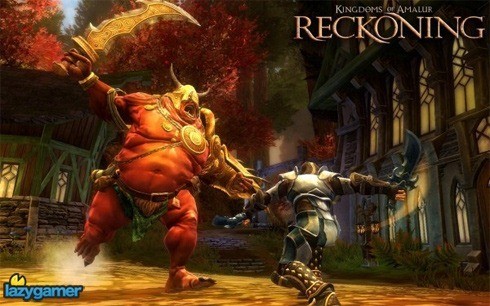
· While fantasy games are experiencing a renewed resurgence in popularity, they’re still a genre that is plagued with repetitive quests and situations. What is KOA doing to stand out and make the mission experiences and events more unique?
Really good question, and one our narrative department kept close to its heart throughout production. One thing we put a lot of narrative focus on was pushing the quest design to be about more than an isolated incident. The quests try and relate to the story of the town, the region, the world they are part of. They take advantage of the deep, massive lore we have to work with that RA Salvatore set out for us. We wanted each one to feel housed in the overall narrative.
· On a similar note, can we expect diversity in NPCs, or are we fated, as we’ve seen with other games, to listen to the same repeated dialogue?
We spent a great deal of time on our characters in Amalur and care a great deal for them. We were very fortunate to get to work with very talented voice actors, as well, that really brought that huge cast to life. Each character the player can have a conversation with has his or her own story, own background, and his or her own desires and demons. I would again point to the rich lore we had to work with as a good starting point to this. Making sure each one of them had a healthy spectrum of dialogue options to engage the player with was one of the most monumental tasks we had on Reckoning, but I believe players will be thoroughly pleased with the outcome.
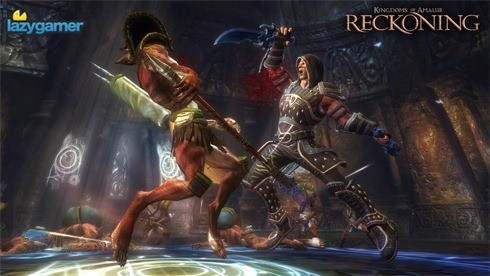
· The game itself is an open world adventure, but how open-ended are the quests? Are there multiple ways of exacting outcomes?
This was a perfect question for lead narrative designer, Andy Auseon, so he responded with this:
“While the open-endedness of our quests varies, we do provide many opportunities for Players to affect change, to alter the outcome of a quest’s specific storyline. Many quests have one or more pivotal points where players are offered a choice. They might push a group to do what’s best for them, lie to a character to spare her feelings, or allow a scoundrel to go free and escape punishment. Not every quest offers these kinds of decisions, but a large number of them do allow Player to express themselves in meaningful ways.”
· With the Destiny system, you’ve thrown traditional levelling up on its head. Can you explain how Destiny differentiates from the standard of putting points in to skills?
This is one of the things that is truly special about Reckoning as an RPG. Throughout development, a common design philosophy was that we didn’t want to tie the player down to a single play style. We wanted to support every possible combination of combat approach a player might have, especially since there are so many countless hours of potential gameplay in Reckoning. We didn’t want a player to get twenty hours in, decide their build wasn’t exactly what they wanted, and feel like they had to start over. Not only are there options in the world for reallocating points, you can also switch your Destiny throughout the game when you want to shift your play style around with the points you have spent. Let’s say you put an even divide of points into thief and mage style talents, for example. You would soon have a nice suite of options of destinies along the rogue, mage, and rogue-mage paths. Choosing a rogue-specific Destiny might serve you well when you find yourself in situations that call for stealth, with high critical hit damage and higher evasion. At any time, however, you might decide you want more mana regen and the mage dodge ability of “Blink”. As a mage/rogue hybrid Destiny (like Warlock, for example), the Blink ability comes with a roguish poison effect, so even when you’re being magically evasive you’re dealing damage.
I could throw dozens of other examples like that to show how destinies allow you to further customize your play style and character past traditional RPG conventions, but really it all means the player gets to make the character they want and evolve that character in unique directions as he or she plays. It could be for role-playing, narrative reasons, or it could be for combat-oriented, systemic ones. Either way, it’s in the hands of the player to decide what destinies to choose.
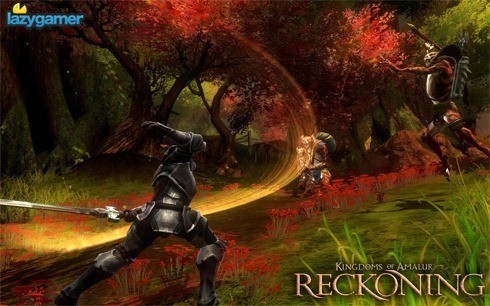
· As an action-RPG, does KOA lean towards, or favour the one genre more, or does it manage to strike a fair balance between the two?
It definitely strikes a balance, but, perhaps oddly, we never thought of it much in these terms after a certain point. While we did set out to make an RPG, we didn’t specifically aim to do one better than the other or even to strike a balance. We just looked at both problems and decided to make them the best they could be. We found neither had to suffer in quality for the other.
· “Kingdoms of Amalur” has a heavy focus on engaging combat, something that’s been missing from similar open-world games. What games have served as inspiration for the combat systems?
For this question, I enlisted the help of lead combat designer, Joe Quadara. He had this to say:
“Our combat team looked at just about anything we could get our hands on: movies, games, comics… everything was fair game for inspiration. It’s fair to say that we looked at every RPG out there, but while the systems were all there, we just were not finding the flashy fluid combat we wanted, so we looked outward to fighting games like Street Fighter and Tekken, and the action beat-em-ups like Devil May Cry, Bayonetta, and God of War. When we looked
at anything, it was with the intent of deconstructing something… like what makes Ryu’s shoryuken such a cool move? Are there valuable lessons we can learn from looking at all the different shoryuken style attacks and identifying which feel the best? In the end, we came up with something that is our own, and I think once gamers get their hands on it, they’ll learn how incredibly deep and discoverable the combat in Reckoning is.”
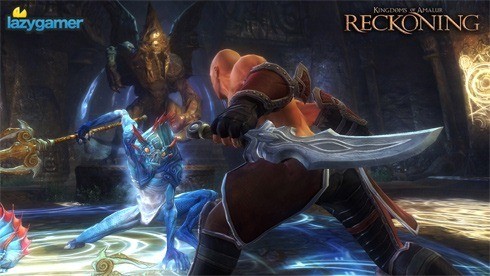
· What measures, like level scaling, have been taken to ensure that combat remains fun and engaging regardless of a player’s level?
I enlisted systems designer, Justin Perez, for this one.
“In order to maintain balance, each space (the entire world is broken up into little chunks we refer to as "spaces") in our game has a very specific range of levels it is allowed to be. When the player enters a space for the first time, we set every object and enemy within it to the closest valid level. So if the player enters an area with a level range of 5-9 at level 6, that becomes a level 6 space. If he enters at level 12 it will be a level 9 space. And so on. The spaces that we intend for the player to get to earlier in the game have the lowest level ranges, and the spaces where the endgame content is held have the highest ranges. That way as you progress through the world and the main quest you are constantly moving into areas with stronger enemies. But if at any point you decide you want to go back to the areas during the beginning of the game, after you have built your character up, you’ll see how much stronger you are than when you first came through the area because the enemies will maintain their original levels.”
· Naturally, our character is going to grow during the course of the game. But how about the game-world itself, does it also evolve and change based on the decisions we make, leading to positive or negative situations?
While player choice is a driving force of the design of Reckoning, literally changing the world visually wasn’t something we decided to dedicate a lot of resources to. For this title, at least, we focused more on supporting choice in other ways. Besides the visceral, moment to moment choices of how to approach a combat experience in Reckoning, throughout the many quests of the world the player can decide the fates of the inhabitants of Amalur, altering the future of towns and factions.
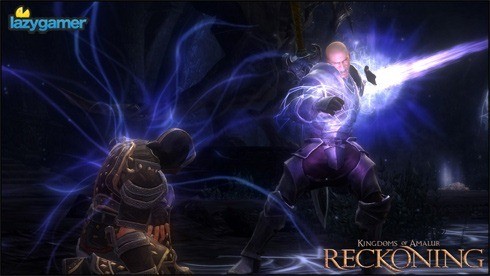
· What kind of visual influence has Todd McFarlane brought to the project? He’s more well-known for his work on the gritty, Spawn Comics and his uniquely dark design but the fantasy genre is a relatively new field for him to explore.
Todd has been vital to the development of the visuals of Reckoning. He meets with the art team over video conference on a regular basis, where a camera in his studio focuses on a screen where he draws critiques of our work and shows us how to improve it. The fantasy genre wasn’t a big leap for him, either. When an artist is as accomplished at his or her craft as Todd, it’s easy to take lessons from one genre into another. If I could take you on a tour of the world of Reckoning, I would be able to point out constant areas where his input is evident. He’s helped us envision and execute on some of our most epic moments of the game, while also adding feedback to much more subtle elements of the world that has guided our approach to things like how we add a weathered appearance to cobblestone roads. Also, despite our lush palette in many parts of the game, we have many moments of foreboding and darkness, something Todd revels in.
· With (at least) three creative geniuses involved, will fans see references or homage to their other works?
Generally speaking, the player won’t see direct references to previous works by our visionaries because of their stake in Amalur being a cohesive, immersive experience for the player. That said, their influence will be ever-present to folks looking for it. We’ve already talked about Todd’s influence and a bit or RA’s, but Ken’s vast experience with RPGs has been like a steady hand at the tiller (albeit a mad genius kind of steady hand) for Reckoning’s development. While I give our visionaries great credit for trusting the teams to handle the nuts and bolts of putting such a massive game together, their big picture direction and experienced feedback has been one of the greatest strengths of this first venture into the world of Amalur.
Thanks to 38 Studios’ and Big Huge Games’ Colin Campbell, Joe Quadara, Andy Auseon and Justin Perez for answering our questions – and EA South Africa for making the Q&A possible. Kingdoms of Amalur: the Reckoning will be available for PC, PS3 and Xbox 360 on February 7 in the US, with a local release on February 10. Gentlemen, clear you calendars!
Remember, there’s a demo available on all platforms – and if you download and play through it, you’ll unlock some pretty sweet Mass Effect 3 gear.
Last Updated: January 25, 2012





















